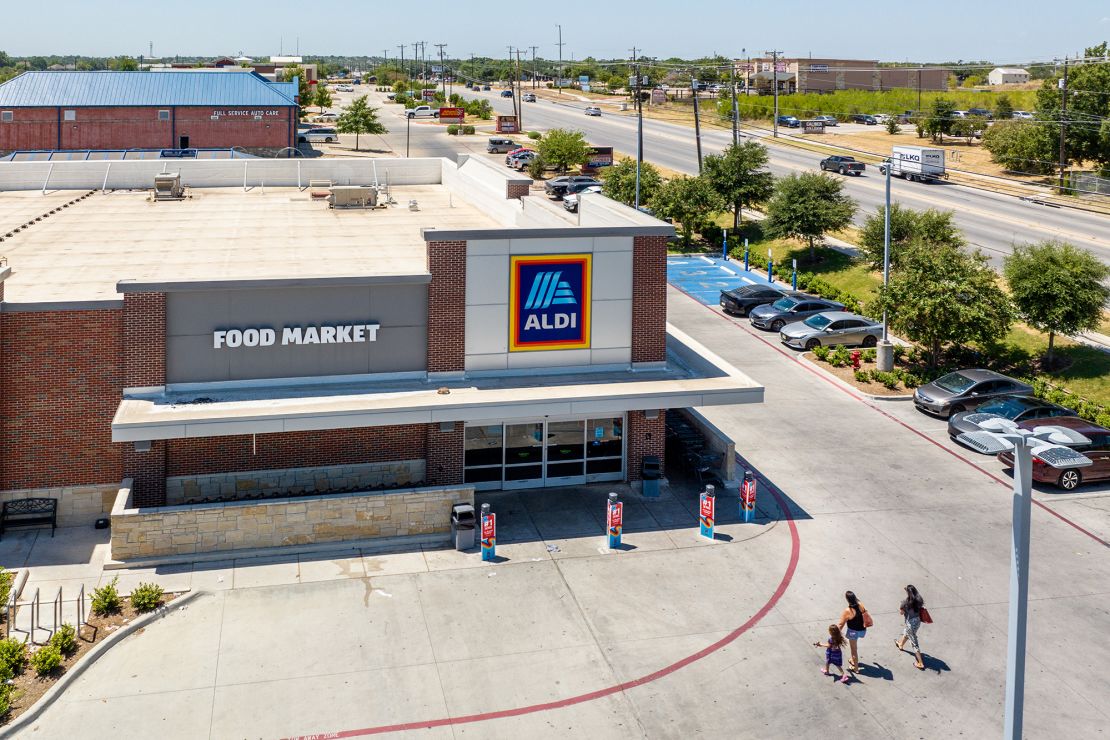Caitlyn Pratt is an avid Aldi shopper, so much so that she crosses state lines a few times a month, driving 45 minutes from her home in Heavener, Oklahoma to the nearest Aldi in neighboring Arkansas.
The distance doesn’t bother her if it means she can do these three things: Stay within budget for her household needs, skip Walmart, and most importantly, indulge in a fun little affordable treasure hunt in a place that Aldi superfans have dubbed the “aisle of shame.”
Aldi, a privately-held German discount grocer that touts a Walmart-like sales pitch of everyday low prices, has operated in the US since 1976 when it opened its first store in Iowa. It operates more than 2,000 stores nationwide and 12,000 stores worldwide.
Inside every Aldi store is a single aisle of merchandise that mostly has nothing to do with groceries. The retailer describes it as “a rotating assortment of specialty items available for a very limited time.” It could be anything from a garden hammock to a furry sweater for your pooch. The prices are startling, with many of these items costing just a few bucks.
Aldi calls it the “Aldi Finds” aisle. Superfans have a more colorful alternative for it – the “aisle of shame.”
Novice shoppers to the grocery chain might think it’s a mishmash of randomly selected stuff shoved into the shelves, sometimes spilling onto the floor after a wave of customers descend on a Wednesday morning and make a beeline for the one item that week that went viral. But often the products are carefully selected and seasonally timed to meet what customers are already looking for.
The Wednesday rush can often be pinned on die-hard Aldi shoppers, 3 million of whom are members of the very active Aldi Aisle of Shame Facebook page and frequently post about their latest aisle of shame hauls.
Pratt is one of them. She happily admits that the aisle of shame is as much a catalyst for her as Aldi’s famously low prices – which research has found can be as much as 15% cheaper than a Walmart in some markets – to get her to make those monthly 42-mile Aldi trips in her car.
Pratt, who’s been an Aldi shopper for more than 12 years, likes Aldi so much she avoids going to a Walmart supercenter just 15 minutes from her home “at all costs.”
“When you go into a Walmart and you’re looking for a can of green beans, you have 18 different options. In Aldi, there’s one, and maybe one other. I can get in and out and get exactly what I need without spending forever in there,” Pratt said.
When she’s done with her grocery list, she hits the middle aisle to scoop up a bargain or two on a variety of other items.
Aldi Finds might include anything from shovels, plastic garden gnomes, patio rugs, deck furniture (depending on the season), to candles, bedding sets, greeting cards, sneakers, lighting fixtures, pet beds, clothing, exercise equipment and cookware at startlingly low prices.
Some items, such as sneakers, are substitutes for name brands and priced at $13 for a pair.
The miscellaneous mix is refreshed weekly, usually on Wednesday. “Fans love our ALDI Finds aisle because it takes the average grocery trip from errand to adventure,” the company said in an email to CNN.
Pratt said her region has it’s own tongue-in-cheek descriptor for the aisle.
“In the south, we call it the ‘aisle of sh*t,’” she joked. “Because on unnecessary things, I probably spend like $150 at Aldi every time that I go there,” Pratt said. “I get so much sh*t for $150, half of which are not groceries.”
Those purchases have included outdoor rugs, patio sets, planters, lanterns, candles, cookware, pillows, pet beds and pet clothing. “When my friends come to my house they don’t even ask me anymore where I’ve got some new things. They know it’s Aldi,” Pratt said.
Aldi, describing the process behind stocking the aisle of shame, said a team of trend experts and buyers spot rising product trends and “source the best products at the lowest possible prices.”
“It often takes ALDI nine months or less, bringing in relevant items faster than competitors,” it said, and that includes food items, such as a Seafood Boil that it tested through the aisle of shame last summer, and which the company plans to bring back this year.
One aisle of shame item – a sparkly $13 wrap dress – had quite a viral moment last fall and was featured across numerous media outlets, including Good Morning America, after shoppers flooded social media with photos of the versatile dress that seemed to compliment a variety of body shapes. No word on whether that product will be restocked, however.

Britney Henderson, who lives just north of Atlanta, Georgia, recently bought a pair of hanging bamboo pendant lamps from Aldi for $9 each for her bedroom and promptly posted about it on the Aisle of Shame Facebook group.
Like Pratt, she shops at Aldi two or three times a month. It’s a 30-minute drive for her but she generally prefers the grocery quality and prices at Aldi versus other discount supermarkets, including Walmart.
Before her trips, she updates herself on recent posts on the Aisle of Shame Facebook page.
“If something pops up on there and I think, oh my gosh, I’ve got to have it, I try to get to the store as soon as I can. If you don’t, it is gone,” she said, sharing that she was wearing shoes she also bought at Aldi during the interview. One item she couldn’t snag was the viral wrap dress from 2022.
Sometimes she tries to avoid the aisle when she’s adamant about sticking to her budget, but it’s a struggle.
“I’m almost embarrassed by it,” Henderson said.
Aldi is keen to saturate the US landscape – small towns to large cities – with its efficient, no-frills, lowest prices, small-sized hybrid grocery/discount stores. And it poses an increasing competitive threat to other retailers such as Walmart, Target and Costco.
“The stores have limited assortments, heavily focused on private label products. Their overall messaging to customers effectively is that “we make things more efficient and curate an assortment for you so that you don’t have to pay all those extra costs,” said John Clear, senior director in the consumer and retail group of global consulting firm Alvarez & Marsal.

It’s the perfect positioning for the current state of the US consumer, he said. “It’s a clear and succinct message for the time that we’re in, where customers are stretched both where their wallets are tight and they’re time-poor,” Clear said.
The chain checks two boxes for shoppers: Low-priced, good quality affordable groceries and an efficient shopping experience lacking an overwhelming product choice in huge stores, “so it makes it easier for shoppers to get in and out quickly,” he said. It helps that stores have less than a dozen aisles.
In March, the company announced plans to expand its footprint by adding another 800 stores nationwide by 2028, on top of the more than 2,300 stores it already has in the US.
“Our growth is fueled by our customers, and they are asking for more ALDI stores in their neighborhoods nationwide,” Aldi CEO Jason Hart said in a statement. “With up to 40% savings on groceries, new customers are inspired to try us out, and existing customers keep coming back. “

The aisle of shame serves a strategic business purpose as well. Although Aldi declined to disclose annual sales in the US or globally, Clear estimates that 10% to 15% of annual sales, and “several multiples of that” contribute to profit margins just from aisle of shame purchases.
“The way I think about that middle aisle is that traditionally customers spent a lot of time shopping the outside of the store, which is frozen, chilled, fresh, freezer,” Clear said, adding that those sections tend to be lower margin areas.
“Products like milk and eggs, flour and sugar drive [shopper] frequency because of Aldi’s low prices,” he said. However, stores typically don’t make big profits off of low-margin products unless they sell a lot of them.
The Aldi Finds items, combined with Aldi’s own higher priced private label grocery offerings (which make up 80% to 90% of grocery items) like olive oil however, tend to be more profitable.
Products in the aisle of shame are profit-boosting additions, Clear said. “It’s plastics and textiles that they import directly from overseas.”
“The customers who come in and only buy milk and eggs are not great for Aldi. No one really makes money off of that,” he said. “You have to get that customer who comes in once or twice a week to also pick up some other products. That’s where this aisle of shame fits in and helps Aldi offer its low prices overall.”











